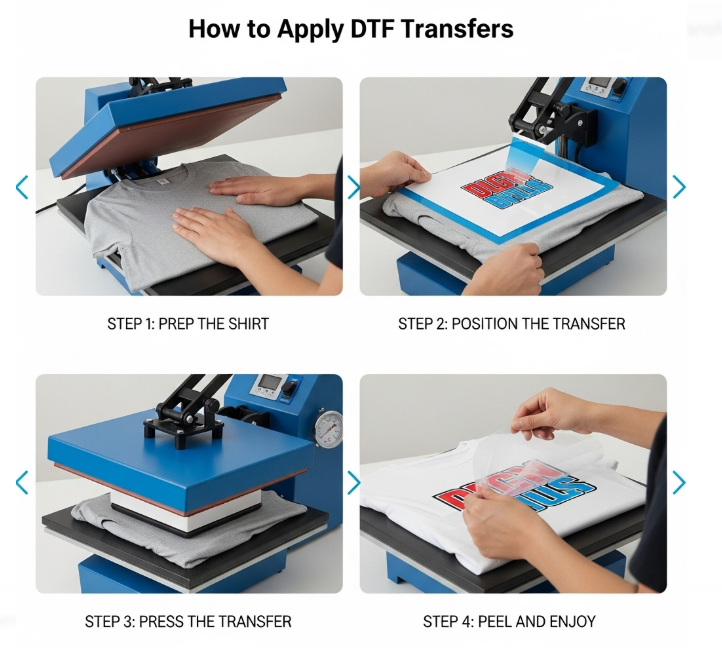
How to Print DTF Transfers at Home
How to Print DTF Transfers at Home: A Step-by-Step Guide
If you want to print your own custom designs at home, DTF (Direct-to-Film) printing is a great choice. It produces bright, durable, and professional-quality prints on many types of fabric. With the right setup, you can easily learn how to print DTF transfers at home and start creating custom T-shirts, hoodies, and more.
What Is DTF Printing?
DTF printing is a digital printing method where your design is printed onto a special transfer film. The printed film is then applied to fabric using heat and pressure. This process gives vibrant, long-lasting prints that work on both light and dark materials.
The DTF process includes three key steps:
-
Printing the design on DTF transfer film.
-
Applying adhesive powder to the printed film.
-
Heat pressing the design onto fabric.
This technique is ideal for printing on cotton, polyester, blends, or even leather.
What You Need to Print DTF Transfers at Home
Before starting, make sure you have all the materials and tools required for DTF printing.
-
DTF Printer: A specialized printer that can handle DTF inks. Some people convert inkjet printers for this purpose.
-
DTF Transfer Film: A special film that holds your design before heat pressing.
-
DTF Inks: Pigmented inks designed for DTF printing to ensure bright and lasting results.
-
Adhesive Powder: This powder helps the ink stick to the fabric during the heat press.
-
Heat Press Machine: Needed to apply heat and pressure to the design.
-
Cutter or Scissors: Used to trim around your design before pressing.
Having the right materials ensures you get professional-quality prints every time.
Step-by-Step Guide to Printing DTF Transfers at Home
Step 1: Set Up Your DTF Printer
First, make sure your printer is ready. If you’re using a converted inkjet printer, install DTF inks in the ink tanks. Load the transfer film into the paper tray with the correct print side facing up. Adjust the print settings for DTF film. Prepare your design on your computer before printing.
Step 2: Design Your Artwork
Create your design using software like Adobe Illustrator, CorelDRAW, or Canva. Keep your design high-resolution for crisp results. Save it as a PNG or TIFF file. Think about the size and placement of your design on the garment before printing.
Step 3: Print the Design onto DTF Transfer Film
Now print the design onto the DTF film. Make sure to print it as a mirrored image, so it appears correctly on the fabric. Use high-quality print settings to get strong colors and sharp details. Let the print come out carefully to avoid smudging.
Step 4: Apply Adhesive Powder
Right after printing, sprinkle the adhesive powder onto the wet ink. Move the film gently to ensure even coverage. Shake off any extra powder so that only the printed areas hold the adhesive. This step ensures that your design bonds properly to the fabric.
Step 5: Cure the Adhesive Powder
Next, cure the adhesive powder. Place the film in a curing oven or use a heat press at a lower temperature. Heat it for about 2–3 minutes at 110°C (230°F). The powder will melt slightly and form a smooth adhesive layer.
Step 6: Preheat Your Heat Press
Set your heat press to the right temperature—usually between 160°C to 180°C (320°F to 350°F). Adjust the pressure to medium or firm. Preheat it before starting the transfer to get consistent results.
Step 7: Transfer the Design to Fabric
Lay your T-shirt or other garment on the heat press. Pre-press for 5–10 seconds to remove moisture and wrinkles. Then place the DTF film on the fabric with the design facing down. Press for 15–20 seconds. The heat and pressure will transfer the design from the film to the fabric.
Step 8: Peel the Film
After pressing, let the design cool for a few seconds. Then gently peel off the film. The design should now be attached to the fabric with bright and clean edges.
Step 9: Post-Press (Optional)
For better durability, cover the design with parchment paper or a Teflon sheet and press again for 5–10 seconds. This helps the print bond tightly and gives it a smoother finish.
Tips for the Best DTF Printing Results
-
Use high-quality materials: Choose good DTF films, inks, and powders for the best finish.
-
Test small prints first: Before making large designs, test a small print to check temperature and pressure settings.
-
Avoid too much heat: Excessive heat or pressure can damage the design. Always follow the manufacturer’s guide.
-
Store materials properly: Keep your DTF film and powder in a dry place to avoid moisture problems.
-
Follow washing instructions: Wash DTF-printed garments inside out with cold water. Avoid bleach or harsh detergents.
Why Choose DTF Printing at Home?
Printing DTF transfers at home gives you full creative control. You can design and print unique items for personal use or even start a small business. It’s more affordable than outsourcing, and once you learn the process, it becomes quick and reliable.
DTF printing works on many fabrics, so you can create custom T-shirts, hoodies, tote bags, and accessories without worrying about color limitations.
Conclusion
Learning how to print DTF transfers at home is simple once you understand the process. With the right printer, films, inks, and heat press, you can achieve bright, durable, and professional prints. DTF printing gives you the freedom to customize your clothing and products with ease.
Whether you’re making gifts, launching a clothing brand, or exploring a new creative hobby, DTF printing is a great way to bring your ideas to life from the comfort of your home.
Check Out Our Other Products
Please click to buy UV DTF Inks.
More information

